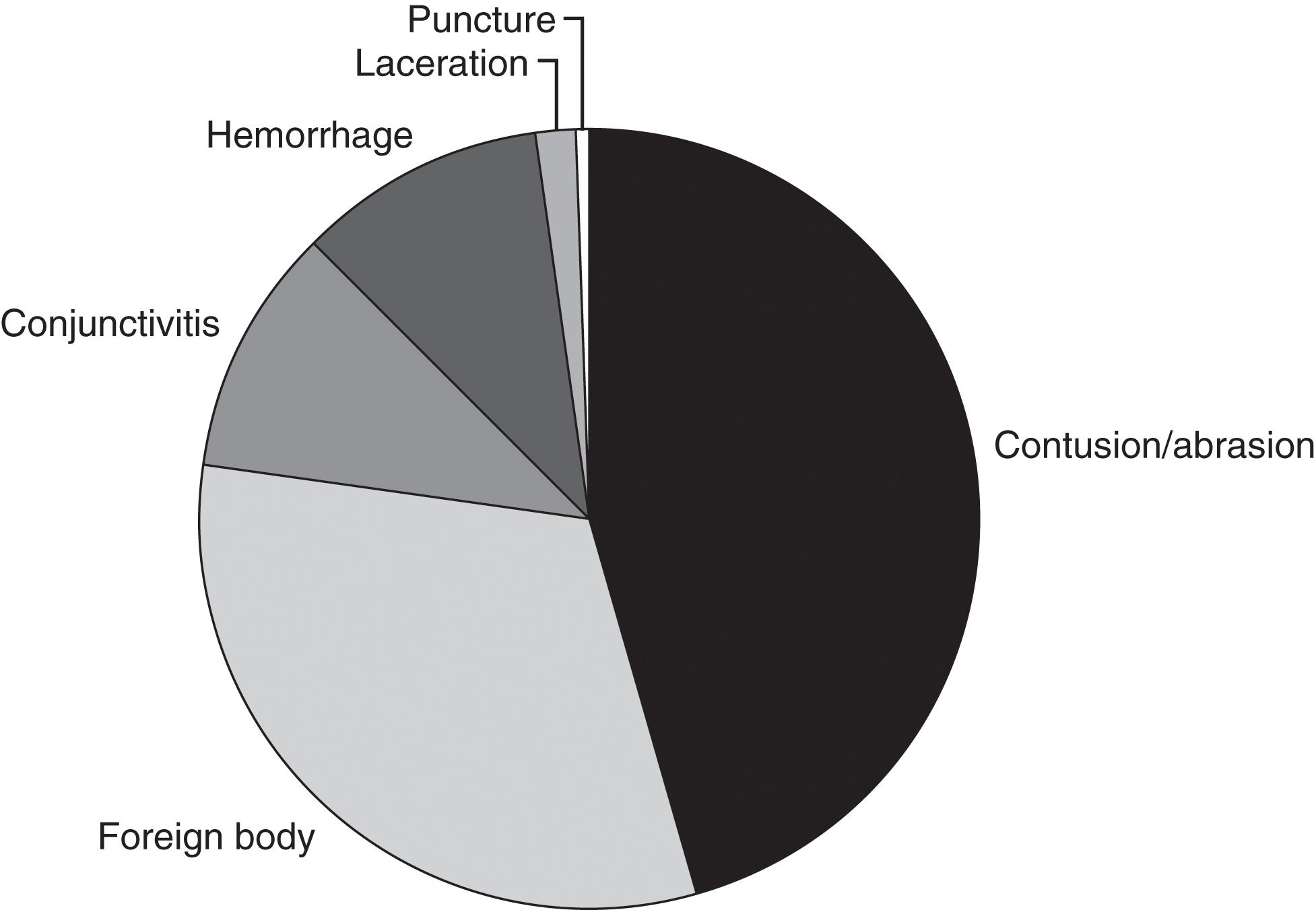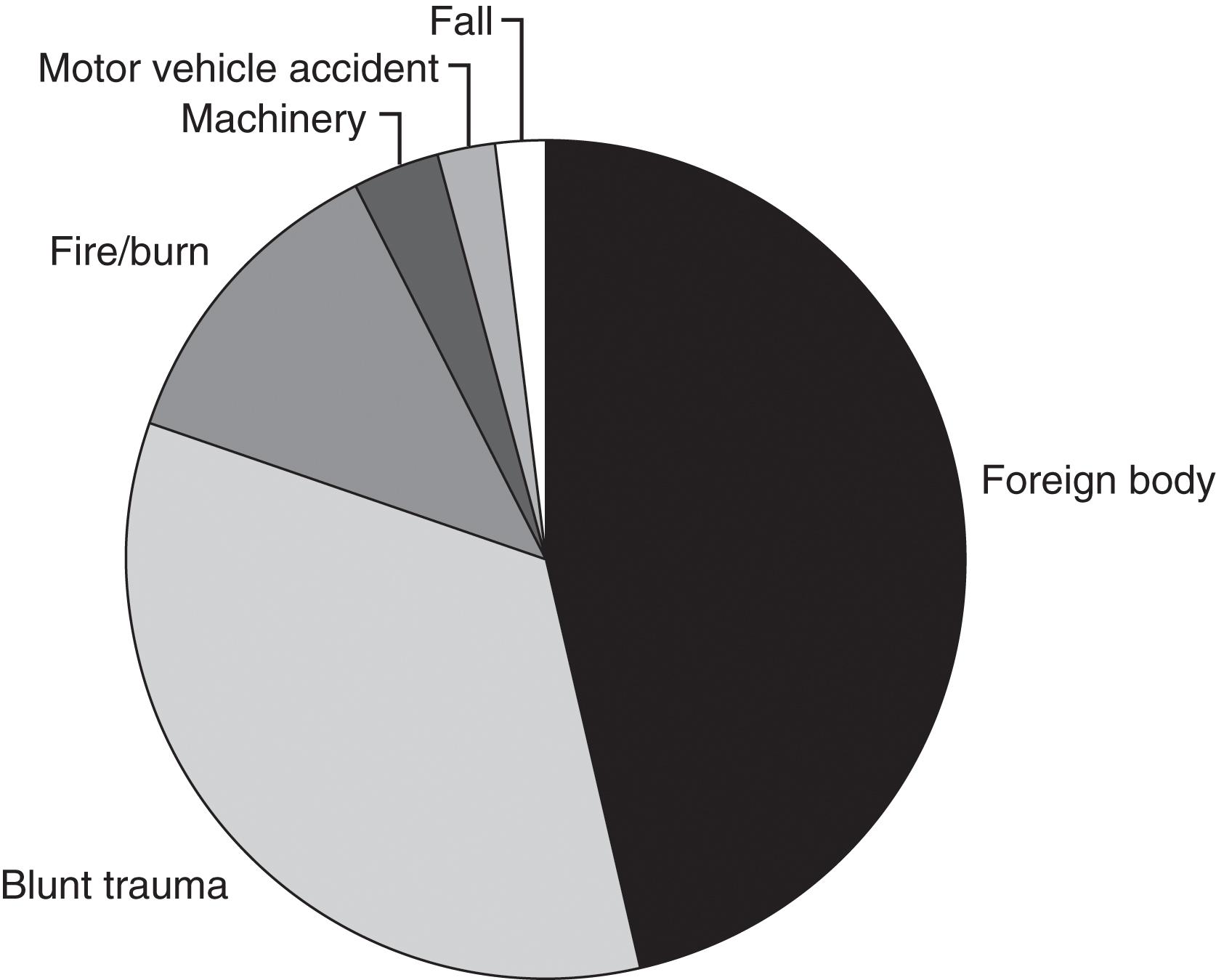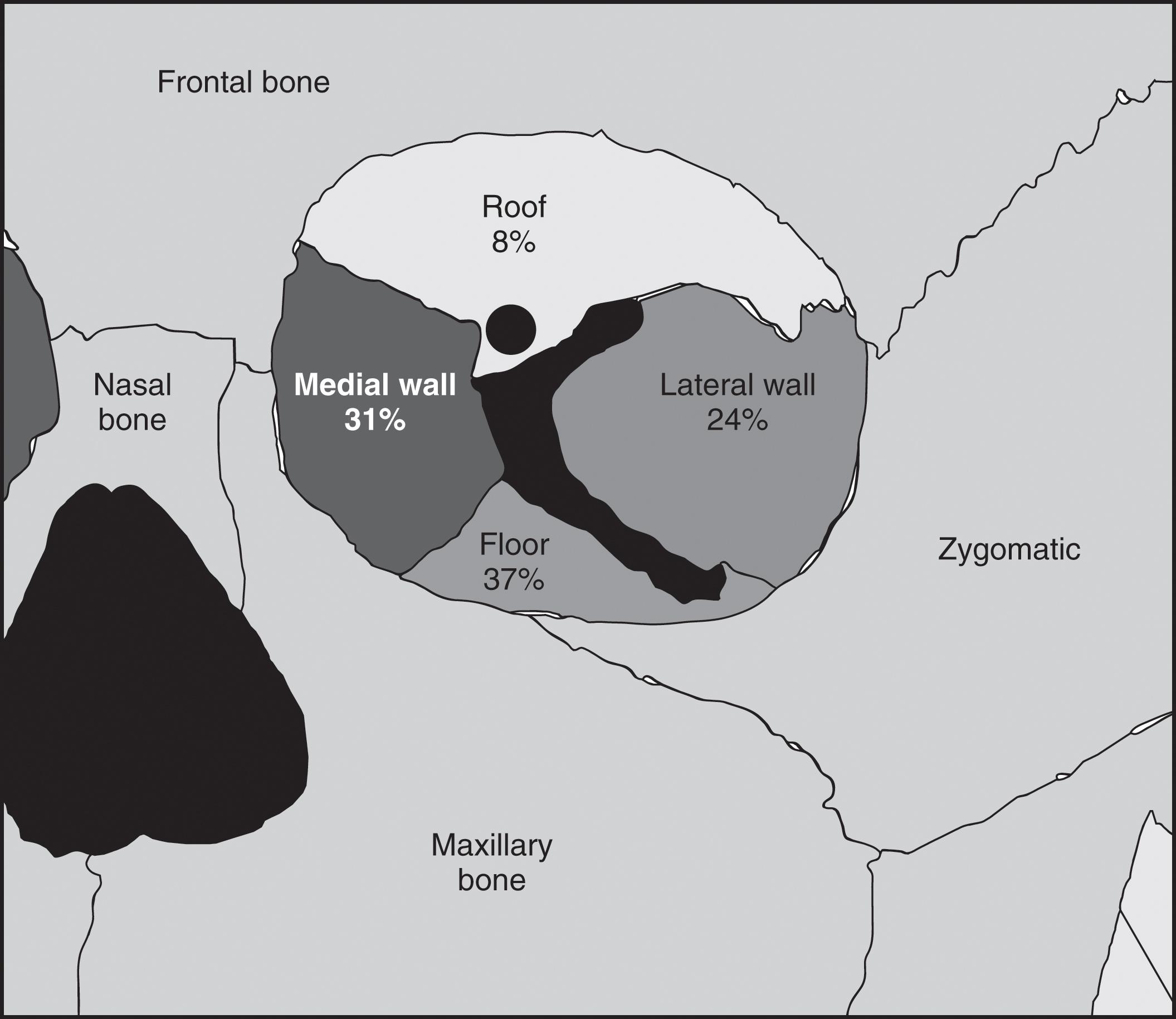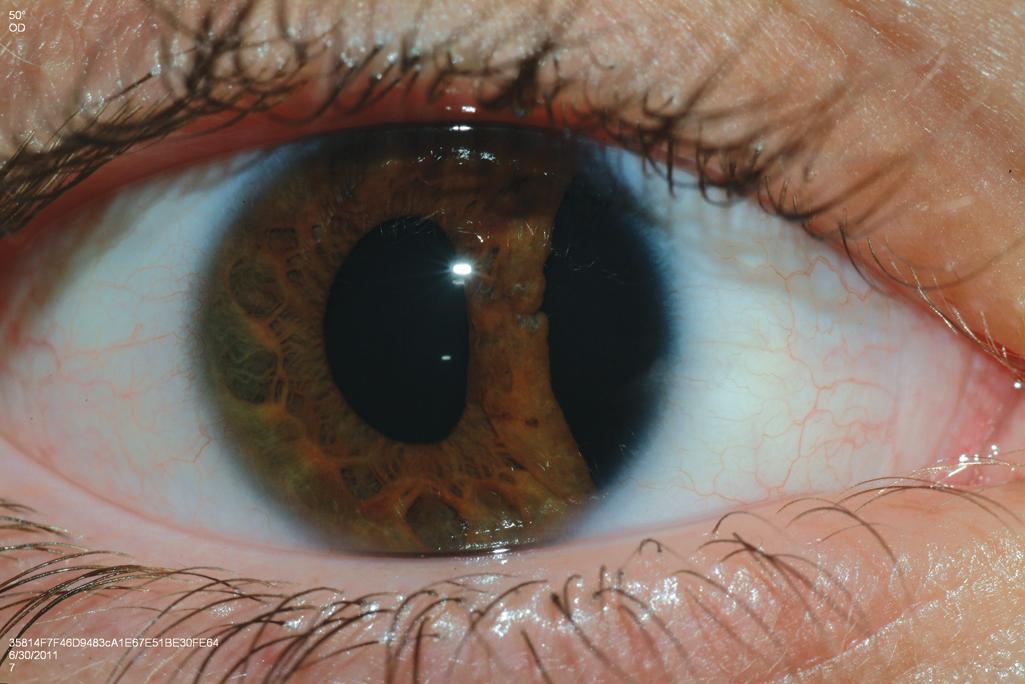Physical Address
304 North Cardinal St.
Dorchester Center, MA 02124
Trauma surgeons and emergency physicians are frequently confronted with evaluating and managing severe eye injuries, most of which will require immediate consultation and referral to an ophthalmologist. Herein, we describe the breadth and depth of traumatic ocular emergencies that may be encountered and an approach for evaluating and managing these complex injuries. Timely diagnosis and care are critical for achieving the best outcomes.
When facial fractures are limited to the orbital bones, an ophthalmology consultation is sufficient to develop a management plan. In more extensive fractures involving the nasopharynx, skull, maxilla, and mandible, a collaborative approach including otorhinolaryngology, plastic surgery, ophthalmology, and oral-maxillofacial surgery may be needed. The decision for appropriate triage is made within the emergency department, and we hope to provide useful guidelines to aid in this decision making ( Fig. 1 ). Direct injury to the eye requires the immediate involvement of an eye care provider. Severely injured patients may be unable to cooperate with extensive ocular examination, and management decisions will be based on limited objective eye findings during the primary trauma survey.
In obvious open globe injuries, the emergency physician and the trauma surgeon can aid in obtaining a history of the injury and making the prompt decision for radiologic evaluation. When an intraocular foreign body (IOFB) is suspected, or a thorough history cannot be elicited, an immediate orbital computed tomography (CT) scan should be obtained. Magnetic resonance imaging (MRI) should be avoided in trauma cases involving the eye, as rotational movements of an IOFB in the MRI can lead to permanent, irreversible damage within the eye. After the primary survey, a shield should be placed over the eye for protection, and the remainder of the evaluation and management should be deferred to an ophthalmologist. Importantly, the shield should rest on bony landmarks of the face and should avoid imparting any pressure on the eye itself. The purpose of the shield is to mitigate contact with the eye by the patient or any other individual. In particular, the emergency physician should absolutely avoid measurement of intraocular pressure when an open globe injury is suspected. The team should also avoid attempting to remove a foreign body or manipulating the eye in any manner, when an open globe injury is suspected. The patient should also be asked to avoid maneuvers that may cause increased orbital pressure or intraocular pressure and intraocular hemorrhage, such as coughing, nose-blowing, or Valsalva maneuver. The patient should be urged to rest quietly until the wound has been repaired. A tetanus vaccine should be given, if indicated, and an intravenous fluoroquinolone (e.g., levofloxacin, typically 750 mg) can be given for its superior intraocular penetration relative to other antibiotics.
When an open globe is not clearly obvious, a full ocular examination is carried out in a methodical fashion, beginning with gross external inspection and visual acuity measurement in each eye, independently, with each eye covered. Optic nerve function is assessed by testing for a relative afferent pupillary defect (RAPD), and if appropriate, intraocular pressures of each eye are measured, and a careful slit-lamp examination is performed. Dilated funduscopic examination can be performed by those with the requisite training. If the combination of clinical findings and ancillary testing is not clearly indicative of an open globe injury, but the suspicion remains high, then formal exploration under anesthesia may be necessary. Signs of an open globe injury include, but are not limited to, protruding intraocular content or foreign body, an irregular or teardrop-shaped pupil, iris disinsertion (iridodialysis), uveal prolapse (e.g., brown intraocular pigmented tissue externalized from the eye), significant fluorescein leaking/staining from the cornea (a positive Seidel sign), vitreous hemorrhage (loss of the red reflex), and diffuse 360-degree or sectoral, bullous subconjunctival hemorrhage. Pigmented debris on the corneal surface may represent prolapsed iris through a full-thickness corneal wound, and it should not be manipulated. Photo-documentation of trauma is recommended whenever feasible and should be performed in a manner compliant with the Health Insurance Portability and Accountability Act and stored on a secure server. Prompt management by the initial emergency physician or trauma surgeon can have a profound impact on the ultimate visual function of these patients, and familiarity with the various types of urgent eye injuries will promote a system of ideal triage ( Fig. 2 ).
To understand the full spectrum of ocular trauma, it is important to understand some basic, standardized terminology. An open globe injury refers to a full-thickness opening of ocular tissue; the term “ruptured” globe has also been used interchangeably, but “open” globe is the preferred term. An open globe injury can be further classified as a nonpenetrating injury (blunt trauma), penetrating injury (entry wound without an exit wound), or perforating injury (entry and exit wound). In contrast, a closed globe injury is a trauma to the eye with the absence of a full-thickness opening of the ocular tissue.
These injuries are further classified by location. In open globe injuries, zone I injuries refer to an injury involving the cornea or limbus (the margin where the cornea ends and the sclera begins). Zone II injuries refer to trauma involving the limbus to 5 mm posteriorly into the sclera. Zone III injuries refer to trauma involving tissue that is more than 5 mm posterior to the limbus. In closed globe injuries, zone I refers to injuries involving the ocular adnexa (eyelids, lacrimal gland), conjunctiva, sclera, or cornea. Zone II refers to trauma involving the anterior segment, including the lens, zonules, and pars plicata. Zone III injuries refer to trauma involving the posterior segment, including the vitreous, retina, optic nerve, choroid, and ciliary body. When classifying an injury, one should use the highest zone involved. For example, a bullet leading to a perforating open globe injury that includes the cornea anteriorly (entry) and the central retina or macula posteriorly (exit) would be classified as a zone III open globe injury. In general, the higher the zone of injury, the worse the prognosis for vision.
Ocular trauma in the United States occurs at an estimated rate of 2 million eye injuries per year (6 per 1000 population). Data gathered by McGwin et al from national ambulatory care surveys and hospital discharge records reveal that most eye injuries in the United States are treated in emergency departments (50.7%), followed by private physicians’ offices (38.7%), and outpatient (8.1%) and inpatient (2.5%) facilities. Demographic analysis of the highest-risk groups reveals that eye injury rates are highest among males in their 20s, with no clear difference among ethnic groups. Though less frequent in the elderly, ocular trauma in this group is most common after a fall, occurring most commonly at home; when ocular injury occurs in the setting of a fall, it typically entails a contusion, with an open globe injury or orbital fracture occurring in less than 15% of cases.
The rate of eye injury begins to climb later in adolescence, with the peak incidence in the third decade, followed by a slow decline thereafter. A second peak occurs in the elderly. This bimodal incidence in younger and older adults, as well as higher rates in males, is a reflection of the types of high-risk activities younger males engage in and the propensity for injuries and falls seen in older adults. These trends apply to injuries in these groups in general.
The setting in which an injury occurs has a marked impact on the severity and the prognosis for visual recovery. A study on the rate of eye injuries in the workplace reported that open globe injuries were the most common (46%), followed by injury to the surrounding ocular adnexal structures (20%), orbital fractures (11%), and traumatic hyphemas (11%). Interestingly, the vast majority (approximately 90%) of eye injuries occur in settings in which protective eyewear can have a major impact (e.g., workplace, sports activities, such as baseball, paintball, and airlift gun play). In fact, in many of these settings, eyewear is mandated but is not being worn at the time of injury. Thus, it is estimated that up to 90% of eye injuries could be prevented if protective eyewear were worn in these settings.
Of the small number of eye injuries related to motor vehicle accidents (estimated at 1.8% of all eye injuries in the United States), very few present as open globe injuries. The mandated use of seatbelts has resulted in a twofold decrease in the number of eye injuries. Curiously, this reduction has been offset by a twofold increase in eye injuries in accidents in which airbags have been deployed. The most frequent injury mechanism related to motor vehicle accidents is impact with the windshield, followed by the airbag, steering wheel, and flying glass. However, these statistics must be viewed in the context of the decreased number of fatalities with the advent of airbag and seatbelt use.
Overall, only a small percentage (2.3%) of eye injuries encountered in the emergency setting present as lacerations and punctures ( Table 1 and Fig. 3 ). The most common causes of eye injuries in this setting are foreign bodies (44.6%) and blunt trauma (33.0%) ( Table 2 and Fig. 4 ). In the subgroup of patients with blunt trauma, many of these injuries represent ruptures of the sclera that may not be clearly obvious to the examiner. In these cases, the examiner must rely on the key clinical findings associated with occult scleral rupture, as outlined in the later section on diagnosis. Werner et al reported on these occult scleral ruptures and found that they can represent up to 25% of all potential ruptured globes. Of these suspected cases of occult rupture, roughly one third were actually found to have eye ruptures at the time of surgical exploration.
| Type of Eye Injury | Frequency (%) |
|---|---|
| Contusion/abrasion | 44.6 |
| Foreign body | 30.8 |
| Conjunctivitis | 10.2 |
| Hemorrhage | 9.9 |
| Laceration | 1.8 |
| Puncture | 0.5 |

| Mechanism of Eye Injury | Frequency (%) |
|---|---|
| Foreign body | 44.6 |
| Blunt trauma | 33.0 |
| Fire/burn | 12.0 |
| Machinery | 3.1 |
| Motor vehicle accident | 2.3 |
| Fall | 1.8 |
| Firearm | <1.0 |

There is a significant association of orbital fractures found in patients presenting with head trauma. In a large study of 4,426 U.S. Army soldiers with facial and orbital fractures, orbital floor fractures were found in 26%. Within this group, there was also a 30% incidence of injury to the globe and a 70% incidence of concomitant bodily injury. Fractures of the orbital floor and medial wall make up the majority of fractures, with the lateral wall being the third most likely site of fracture, and a smaller number of fractures occurring in the orbital roof ( Fig. 5 ). The orbital floor is most susceptible just medial to the infraorbital groove, whereas the medial wall is most likely to rupture at the lamina papyracea, a paper-thin bony septum.

The mechanisms of injury to the eye and surrounding structures are largely associated with foreign bodies, blunt trauma, and thermal and chemical burns. Machinery, motor vehicle, and firearms are among the less common causes (see Table 2 and Fig. 4 ). There is often appreciable overlap, and the physician must consider the impact of these mechanisms in combination and treat each injury individually. For example, an ophthalmologist must consider the risks and benefits of irrigating an eye with a chemical alkali injury and concomitant open globe injury. Blunt force on an eye can also be described as coup–contrecoup, or compressive force in a manner similar to brain injury. Examples of coup injuries are corneal abrasions, subconjunctival hemorrhages, choroidal hemorrhages, and retinal necrosis. Another example of a coup injury is a hyphema resulting from iridodialysis (shearing off of the iris root) or iris injury from impact from paintball and airsoft gun pellets ( Fig. 6 ). A classic example of a contrecoup injury is commotio retinae, with anterior forces being transmitted to the retina and causing retinal whitening due to disruption of the photoreceptor outer segments (and additional layers of the retina for larger forces). Compression of the globe usually causes scleral rupture. These open globe injuries are described later.

Orbital fractures can be caused by blunt forces leading to an increase of intraorbital pressure resulting in blowout fractures of the medial wall and floor or by direct injury to the bones of the face resulting in fracture of any of the four walls. Because the lateral wall and roof are the most resistant to fracture, injury of these bones is an indicator of significant force to the face and eyes, and concomitant injury to the globe should be carefully evaluated. Foreign body penetration of the orbit can involve the eye directly or any of the surrounding structures.
Chemical and thermal injuries to the eyelids and adnexa must be evaluated over the long term, well beyond the healing period for the superficial tissues. Burns to the eyelids and skin lead to scarring and contraction of the eyelids, which place these patients at risk for eyelid retraction and exposure damage to the cornea and ocular surface secondary to poor eyelid closure. Thus, long-term follow-up is important in this patient group, particularly if they are in a critical care setting. They must be treated with aggressive lubrication to the eyes until they demonstrate an ability to blink voluntarily and protect the eye. All intensive care units and trauma wards should have written eye care protocols for the management of these patients.
Open globe injuries are classically divided into nonpenetrating and penetrating injuries. The former group is caused by blunt trauma that causes a forceful compression of the eye and results in the physical rupture of the eye wall. The location of the rupture is typically in the areas where the eye wall is the thinnest, namely, the corneoscleral junction (the limbus), just posterior to the muscle insertion sites in the sclera, and at the posterior attachment of the optic nerve. Ruptures posterior to the limbus may be difficult to identify, and the clinician must be familiar with the signs of occult rupture, which are described in the section on diagnosis.
When the mechanism of injury involves penetration of the globe, the site of entry is usually visible and the decision for surgical intervention is straightforward. The three variables to consider when an entry wound is identified are (1) whether the penetrating object has exited the eye, (2) whether a foreign body is within the eye, or (3) whether it has passed through the entire eye (perforation), in which case a posterior exit wound should be suspected, and the foreign body may be located within the orbit.
If there is evidence of an intraocular or intraorbital foreign body, the type of material may also have implications in toxicity to the eye and the risk of infection to the orbit and the eye ( Table 3 ). When the history of the type of injury is unclear, an orbital CT should be requested immediately and a shield placed over the eye. An MRI should never be performed when an intraocular or intraorbital foreign body is suspected, and it could lead to more harm to the patient if a magnetic foreign body is present. Even if the foreign body is easily accessible and protruding from the eye or surrounding structures (e.g., the eyelid or bony orbit), the emergency physician or trauma surgeon should not remove the object. It may be tamponading intraocular tissue, and its removal in an uncontrolled setting outside of the operating room could lead to expulsion of normal intraocular tissue through the wound or a blinding suprachoroidal hemorrhage. For example, in a series of TASER injuries to the eye and orbit, one third of the injuries involving the eyelid also resulted in a concomitant open globe injury; removal of the TASER from the eyelid in the operating room facilitated concurrent open globe repair. A shield should be carefully placed over the eye of patients with a suspected open globe injury or intraocular or intraorbital foreign body to prevent manipulation of the eye by the patient or any member of the health care team. The extent of the injury can be assessed at the time of surgical repair in the operating room.
| Type of Metal | Cornea | Iris | Lens | Vitreous | Retina | Signs/Symptoms |
|---|---|---|---|---|---|---|
| Iron (siderosis) | Rust-colored corneal stromal staining | Anisocoria/heterochromia | Flower-shaped cataract | Brownish opacities | Diffuse retinal pigmentation | Night blindness, visual field loss |
| Copper (<85%) (chronic chalcosis) | Fleischer ring | Greenish discoloration | Sunflower cataract | Brownish red opacities | Metallic flecks on vessels and macula | Progressive vision and field loss |
| Copper (>85%) (acute chalcosis) | Severe inflammation | Greenish discoloration | Sunflower cataract | Diffuse vitritis | Metallic flecks on vessels | Fulminant inflammation/loss of eye |
| Gold | — | — | Anterior capsule deposits | — | — | — |
| Aluminum/zinc | Minimal inflammation | — | — | — | — | — |
Become a Clinical Tree membership for Full access and enjoy Unlimited articles
If you are a member. Log in here